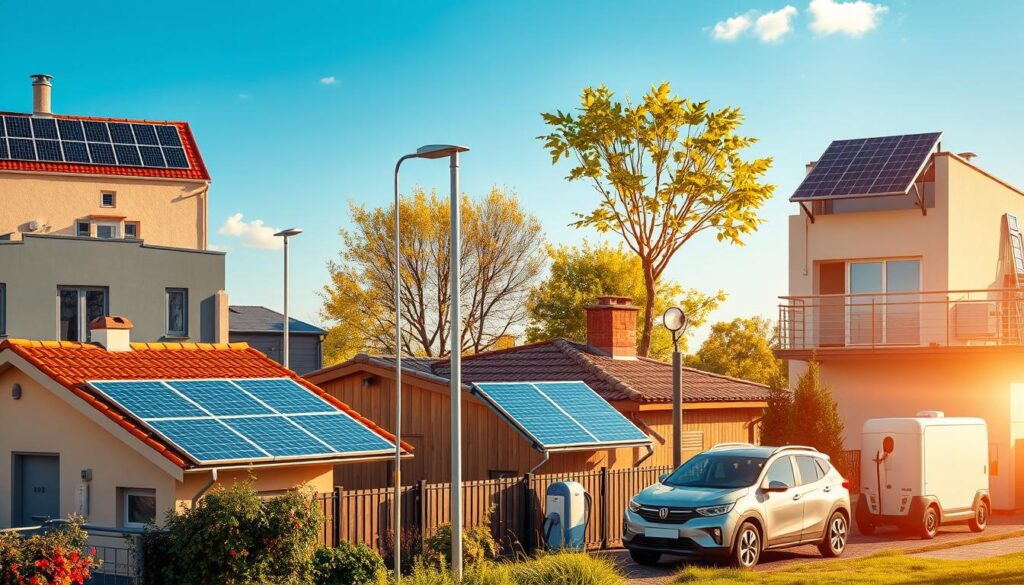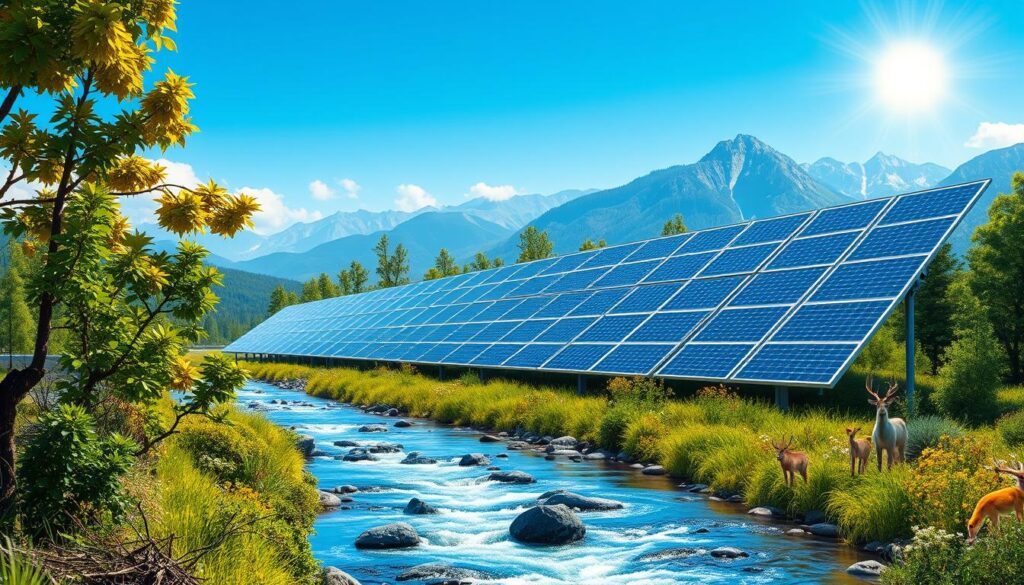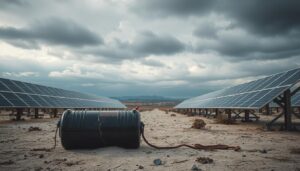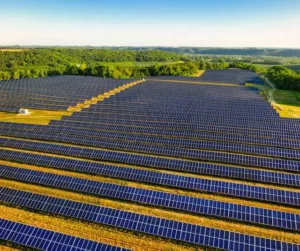Over 40,000 Australian households have journeyed to energy independence with solar power since 2005, a testament to the versatility and growing popularity of this renewable energy source. From powering homes to fueling industrial applications, solar energy has become an integral part of Australia’s sustainable future. In this article, we’ll explore the five most common uses of solar energy that are transforming the nation’s energy landscape.
Key Takeaways
- Solar power has diverse applications, from generating electricity to heating water and powering appliances.
- Solar energy is a renewable and sustainable source that can reduce reliance on fossil fuels and lower greenhouse gas emissions.
- Solar technology is advancing rapidly, making it more efficient and accessible for Australian households and businesses.
- Solar energy is being used in a wide range of sectors, including agriculture, industry, and remote communities.
- Harnessing the power of the sun can contribute to a cleaner, more eco-friendly future for Australia.
Harnessing Solar Energy
The sun’s renewable energy is a powerful and eco-friendly energy solution that can be harnessed in numerous ways to power our daily lives. Solar energy, in the form of light and heat, offers a sustainable living practice that is becoming increasingly popular as solar technology advancements continue to revolutionize the energy sector.
The Sun’s Energy: Light and Heat
The sun’s rays provide both light and heat, which can be captured and converted into usable forms of energy. This makes solar power a green energy alternative that is readily available, reliable, and virtually inexhaustible.
Renewable and Sustainable Energy Source
One of the key advantages of solar energy is its renewable and sustainable nature. Unlike fossil fuels, which deplete over time, the sun’s energy is constantly replenished, making it a clean energy initiative that can be harnessed indefinitely without depleting the Earth’s resources or causing significant environmental damage.
In recent years, the solar industry in Australia has been rapidly evolving, with rooftop solar installations reaching new heights. In 2020 alone, Australian rooftops added a record-breaking 3 GW of solar capacity, demonstrating the growing popularity and acceptance of renewable energy sources.
“During a sunny hour in 2020, South Australia was able to run exclusively on solar power, showcasing the immense potential of solar technology advancements.”
As the world continues to prioritize sustainable living practices and eco-friendly energy solutions, the importance of harnessing the sun’s energy will only continue to grow, making solar power an increasingly vital component of the global clean energy initiatives.
Solar Electricity
One of the most popular solar power applications is the generation of solar electricity. Solar photovoltaic (PV) systems, typically installed on rooftops, convert sunlight directly into electrical energy that can be used to power homes and businesses. As the cost of solar panels has declined and awareness of their financial and environmental benefits has grown, solar electricity is becoming increasingly accessible and widespread, although it still represents a small percentage of overall electricity generation in the United States.
According to recent statistics, nearly 4 million American households are already generating their own power with solar energy. Homeowners can claim a 30% tax credit on the cost of solar systems for their income taxes, making it a more affordable renewable energy source. However, this federal residential solar tax credit is set to decrease to 26% after January 1, 2023, so it’s important for homeowners to act quickly to take advantage of the current incentives.
Solar panels can also save homeowners money as the monthly amount owed on a solar loan is typically less than an average utility bill. Moreover, a Berkeley National Laboratory study has found that solar panels can increase the value of a home. Solar electricity is the most common way solar power is utilized in homes, and it can power the average American home even during winter, as solar panels work in a variety of climates.
For those who can’t install solar panels on their own roofs, community solar programs are a great option. These programs allow multiple people to benefit from a single, shared solar array, dividing costs and installation among participants.
Solar Batteries and Generators
As the world transitions towards more eco-friendly energy solutions, the use of solar energy has experienced a remarkable 33% yearly growth on average over the last decade. This growth has been driven by advancements in solar technology, including the development of solar batteries and generators. These innovative solutions not only harness the renewable energy sources of the sun but also provide a way to store solar energy for later use.
Storing Solar Energy for Later Use
Solar batteries can be connected to a solar power system, allowing homeowners to use solar energy even after sundown or during power outages. With the costs of installing solar energy systems decreasing by over 60% in the last decade, and a typical residential solar system costing around $20,000 (down from $40,000 in 2010), more sustainable living practices are becoming accessible to homeowners. Solar batteries can store excess energy efficiently, preventing it from going to waste and helping to reduce a household’s carbon footprint.
Portable Solar Generators for Camping and Emergencies
In addition to stationary solar batteries, portable solar generators have also gained popularity. These compact, self-contained units combine solar panels, a battery, and an inverter, making them a versatile green energy alternative for camping trips, emergency situations, and other off-grid activities where traditional electricity may not be available. Portable solar generators can provide a reliable source of power during outages, ensuring essential appliances and systems continue running, while also operating silently and without emissions.
Whether it’s solar batteries for home use or portable solar generators for outdoor adventures, these solar energy benefits are helping to drive the transition towards more sustainable living practices and eco-friendly energy solutions.
Solar Ventilation and Heating
Beyond powering homes and businesses, solar energy can also be utilized to enhance sustainable living practices through innovative solar power applications. One such application is the use of solar energy for ventilation and heating systems.
Solar attic fans and other solar ventilation technologies can significantly reduce the burden on traditional HVAC systems by keeping buildings cooler during the summer months. These systems harness the sun’s heat to effectively ventilate and regulate indoor temperatures, providing an eco-friendly energy solution that contributes to sustainable living.
Additionally, solar water heating systems and solar-powered space heating systems use the sun’s heat to warm water and air, offering an energy-efficient way to heat homes and businesses. Liquid-based active solar heating systems are more often used for central heating, with flat-plate collectors, evacuated tube collectors, and concentrating collectors increasing the temperature of the heat transfer fluid by 10° to 20°F (5.6° to 11°C).
These renewable energy sources provide a cost-effective and environmentally-friendly alternative to traditional heating methods, contributing to the growing trend of sustainable living practices in Australia and beyond.
“Solar energy is the future of heating and cooling, offering a clean and efficient solution that reduces our carbon footprint and energy costs.”
As the demand for eco-friendly energy solutions continues to rise, the applications of solar power in ventilation and heating systems are poised to play an increasingly vital role in the pursuit of sustainable living.
What are the 5 uses of solar energy?
As a versatile and renewable energy source, solar power can be harnessed in numerous ways to power our homes, businesses, and everyday lives. In this article, we will explore the top 5 uses of solar energy that are transforming the way we live and work.
- Solar Electricity – Solar cells installed on rooftops can convert the sun’s energy into electricity, reducing energy consumption and saving homeowners money on their monthly utility bills.
- Solar Batteries and Generators – Advancements in solar technology allow for the charging of batteries with solar electricity, enabling the storage of solar energy for later use, even when the sun isn’t shining.
- Solar Ventilation and Heating – Solar chimneys use the power of the sun to heat and cool homes, providing clean, renewable energy without occupying valuable living space.
- Solar Lighting Applications – From outdoor landscape and security lighting to indoor solar-powered lamps, solar energy is revolutionizing the way we illuminate our environments.
- Solar-Powered Appliances – Solar-powered appliances, such as water heaters, space heaters, and ovens, are becoming increasingly popular as homeowners seek to cut down on costs and reduce their environmental footprints.
These 5 uses of solar energy demonstrate the versatility and growing affordability of this renewable resource. As technology continues to improve, the applications of solar power will only continue to expand, making it an increasingly attractive and eco-friendly solution for powering our lives.
| Solar Energy Application | Potential Benefits |
|---|---|
| Solar Electricity | Reduced energy bills, decreased carbon emissions |
| Solar Batteries and Generators | Energy storage, off-grid power, emergency backup |
| Solar Ventilation and Heating | Clean, renewable heating and cooling, efficient use of space |
| Solar Lighting Applications | Outdoor security, landscape illumination, indoor lighting |
| Solar-Powered Appliances | Cost savings, reduced environmental impact |
The widespread adoption of these 5 solar energy applications is a testament to the benefits of this renewable resource, making it an increasingly attractive option for homeowners, businesses, and communities alike.
“The sun, the moon, and the stars would have disappeared long ago… had they happened to be within the reach of predatory human hands.” – Henry Rollins
Solar Lighting Applications
Solar energy has revolutionized the lighting industry, offering innovative and sustainable solutions for both indoor and outdoor applications. From powering landscape lights to illuminating homes and workspaces, solar-powered lighting is becoming increasingly popular due to its numerous benefits.
Outdoor Lighting: Landscape, Security, and Holiday Lights
Solar-powered outdoor lighting has become a game-changer for homeowners and businesses alike. Solar landscape lighting, such as path markers and spotlights, provide elegant and eco-friendly illumination for gardens, driveways, and walkways without the need for wiring or electrical outlets. Solar security lighting, equipped with motion sensors, offers reliable and cost-effective solutions for enhancing the safety of residential and commercial properties. Even festive holiday lights can now be powered by the sun, creating a stunning seasonal display that is both energy-efficient and environmentally friendly.
Indoor Solar Lighting Options
The versatility of solar energy extends to indoor lighting applications as well. Solar-powered desk lamps and pendant lights are becoming increasingly popular, allowing homeowners and office workers to reduce their electricity consumption and embrace sustainable living practices. These indoor solar lighting solutions harness the sun’s energy to illuminate living and working spaces, providing a practical and visually appealing alternative to traditional electric lighting.
| Application | Benefits | Average Installation Time |
|---|---|---|
| Solar Park Lighting | Clean, fast alternative to grid-tie options | Typically a day’s time once the pedestals are in place and dried |
| Solar Lights for Construction | Quick and easy to deploy, no need for noisy generators | Quick and easy installation |
| Solar Lighting with Motion Detectors | Widely used for security purposes, particularly in rural and residential areas | Fast and straightforward installation |
| Solar Retrofit Lighting | Allows for quick installation onto older poles | Efficient and cost-effective solution |
| Solar Lighting for Signage | Eliminates the need for extensive ground excavation and permits, offering a cost-effective solution | Quick and easy installation |
Whether illuminating outdoor spaces or enhancing indoor environments, solar-powered lighting applications continue to revolutionize the way we approach sustainable living practices and renewable energy sources. With their ease of installation, cost-effectiveness, and environmental benefits, solar lighting solutions are becoming increasingly popular in Australia and around the world.

Solar-Powered Appliances
As the world embraces renewable energy sources, a growing number of household and industrial appliances are being designed to harness the power of the sun. These solar-powered appliances offer a range of benefits, from reducing energy bills to minimizing environmental impact.
One of the most significant advantages of solar-powered appliances is their ability to provide energy-efficient and eco-friendly solutions. By utilizing the sun’s abundant and renewable energy, these appliances can significantly reduce the demand for grid-supplied electricity, leading to lower carbon emissions and a smaller carbon footprint.
From solar ovens and water pumps to solar-powered ventilation fans and wearable technology, the applications of solar energy in the world of appliances are diverse and innovative. These solar-powered devices not only contribute to sustainable living practices but also provide a convenient and reliable source of power, especially in areas with limited access to the electrical grid.
To maximize the benefits of solar-powered appliances, it is crucial to understand the optimal usage patterns and energy requirements. The sun’s peak generation period typically occurs between 10 am and 2 pm, making this the ideal time for appliances to operate on solar power. Additionally, pairing solar-powered appliances with energy storage solutions, such as batteries, ensures a continuous supply of electricity, even during times of low sunlight or nighttime.
As the adoption of solar energy continues to grow, the range of solar-powered appliances available on the market is expanding. From energy-efficient refrigerators and washing machines to solar-powered water heaters and pool pumps, the possibilities for harnessing the sun’s energy are endless. By embracing these innovative solutions, homeowners and businesses can contribute to a more sustainable future while enjoying the cost-saving and environmental benefits of solar power.
| Appliance | Typical Power Rating (Watts) | Daily Usage (Hours) | Daily Energy Consumption (kWh) |
|---|---|---|---|
| Refrigerator | 100-300 | 24 | 2.4-7.2 |
| Washing Machine | 500-1,000 | 1-2 | 0.5-2 |
| Air Conditioner | 1,000-5,000 | 4-8 | 4-40 |
| Electric Oven | 2,000-5,000 | 1-2 | 2-10 |
| Clothes Dryer | 2,000-5,000 | 1-2 | 2-10 |
The table above provides an overview of the typical power ratings and daily energy consumption of common household appliances. By understanding the energy requirements of these devices, homeowners can better plan and optimize their solar power system to meet their energy needs effectively.
“The sun’s energy is the key to a cleaner, more sustainable future. By harnessing its power, we can revolutionize the way we power our homes and businesses, reducing our reliance on traditional energy sources and lowering our environmental impact.”
Agricultural and Industrial Uses
The applications of solar power extend far beyond residential settings. In the agricultural and industrial sectors, solar energy has emerged as a versatile and eco-friendly solution. From powering water pumps for irrigation to drying agricultural products, solar energy is transforming the way these industries operate.
In agriculture, solar energy is used to power a wide range of equipment, including generators, pumps, tillers, and motors. This not only reduces reliance on traditional fossil fuels but also provides a cost-effective and sustainable alternative. Solar-powered water pumps, in particular, have become increasingly popular in regions with ample sunlight and limited access to conventional electricity sources.
Solar energy also plays a crucial role in the drying and preservation of agricultural and animal products, such as fruits, grains, and fish. By circulating heated air over the products, solar energy effectively removes moisture, ensuring longer shelf life and better quality.
| Agricultural Applications of Solar Energy | Industrial Applications of Solar Energy |
|---|---|
|
|
In the industrial sector, solar energy is increasingly being adopted to power a range of applications, from machinery and equipment to lighting and HVAC systems. This not only reduces energy costs but also contributes to the overall sustainability of industrial operations. Solar-powered water treatment and desalination plants are also gaining traction, particularly in regions with limited access to clean water.
As the world continues to seek eco-friendly and sustainable solutions, the applications of solar power in agriculture and industry are poised to expand further, driving the transition towards a more renewable and environmentally conscious future.
Water Treatment with Solar Energy
In regions with limited access to clean water, solar energy is proving to be a game-changer in the realm of water treatment. Solar-powered water distillation systems leverage the sun’s abundant heat to evaporate and condense saline or contaminated water, leaving behind pure, drinkable water. This eco-friendly energy solution is particularly beneficial in arid, semi-arid, or coastal areas with ample sunlight and saline water sources.
Solar-Powered Water Distillation
A 633-kilowatt solar power system, costing several million dollars, can provide nearly all the electricity needed to power water treatment units. These solar panels, designed to last up to 25 years, are anticipated to generate 85% of the energy required to power 1,800 homes annually. With over 300 sunny days expected annually, the consistent energy generation ensures the reliable operation of these water treatment facilities.
The solar farm, covering five acres, will remove close to 40 million pounds of carbon dioxide emissions from the atmosphere over the years. The project includes a Single Axis Tracking System composed of more than 3,300 solar electric panels, which are made from sand converted into silicon crystals, enabling the generation of electricity for water treatment plants.
| Metric | Small to Medium-Scale Plants | Large-Scale Plants |
|---|---|---|
| Water Costs (per cubic meter) | $0.2 – $22 | $0.9 – $2.2 |
While the water costs for small to medium-scale solar desalination plants can range from $0.2 to $22 per cubic meter, which is higher than conventional fossil fuel-based plants, the estimated low water costs for large-scale solar desalination plants, ranging from $0.9 to $2.2 per cubic meter, indicate potential viability in the near future.
As the global demand for water continues to rise, driven by population growth and economic development, the environmental benefits of solar-powered water treatment cannot be overstated. With the United Nations Environmental Programme (UNEP) projecting two-thirds of the world’s population facing water scarcity by 2025, solar power applications and other renewable energy sources will play a crucial role in providing eco-friendly energy solutions and sustainable living practices to address this critical challenge.
Environmental Benefits of Solar Energy
Harnessing the power of the sun through renewable energy sources not only meets our energy needs but also delivers significant environmental benefits. By reducing our reliance on fossil fuels, the widespread adoption of eco-friendly energy solutions like solar power can have a profound impact on reducing air pollution and greenhouse gas emissions.
Reduced Air Pollution and Greenhouse Gas Emissions
Generating electricity from solar panels produces no harmful emissions, contributing to improved air quality. In fact, every megawatt-hour of solar energy used can offset anywhere between half to one tonne of carbon dioxide. This reduction in greenhouse gas emissions aids in slowing climate change and mitigating its long-term effects.
Water Conservation and Slowing Climate Change
Solar panels use no water at all to generate electricity, reducing strain on precious water resources. This sustainable living practice is particularly important in regions facing water scarcity. By transitioning to clean energy initiatives like solar power, we can take meaningful steps towards preserving our environment and natural resources for future generations.
As green energy alternatives become more accessible and efficient, the environmental benefits of solar energy will only continue to grow. By embracing this renewable energy source, we can contribute to a cleaner, more sustainable future for all.

“Solar energy is an abundant and free source of power, helping to reduce reliance on finite fossil fuels.”
| Environmental Benefit | Impact |
|---|---|
| Reduced air pollution | Improved air quality |
| Decreased greenhouse gas emissions | Slowing climate change |
| Water conservation | Preserving natural resources |
Conclusion
As the various applications of solar energy have demonstrated, this renewable energy source offers a wealth of benefits for individuals, communities, and the environment. From generating clean electricity to powering lighting, appliances, and water treatment systems, the versatility of solar technology is truly remarkable.
The substantial environmental advantages of solar energy, such as reduced greenhouse gas emissions and air pollution, make it a crucial component in the global transition towards sustainable living practices and eco-friendly energy solutions. As solar technology continues to advance and become more accessible, the adoption of solar power applications is expected to accelerate, empowering Australians to take an active role in shaping a greener future.
Whether you’re interested in harnessing the sun’s energy to power your home, reduce your electricity bills, or contribute to the fight against climate change, the diverse uses of solar energy provide a multitude of clean energy alternatives that can be seamlessly integrated into your daily life. By embracing the benefits of solar energy, you can not only enjoy the cost-saving and environmental advantages, but also be a part of the broader solar technology advancements and clean energy initiatives that are transforming the way we power our world.



